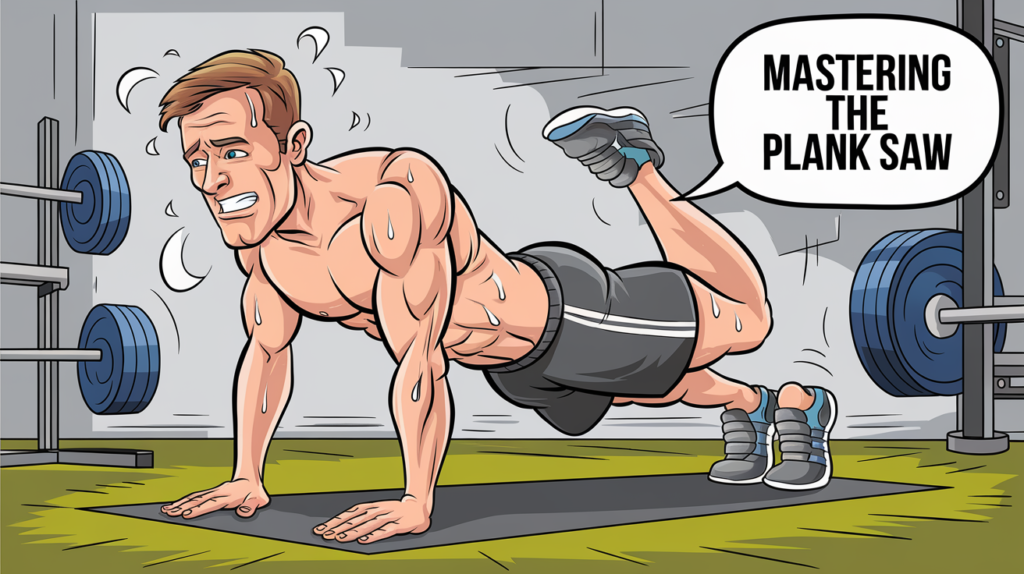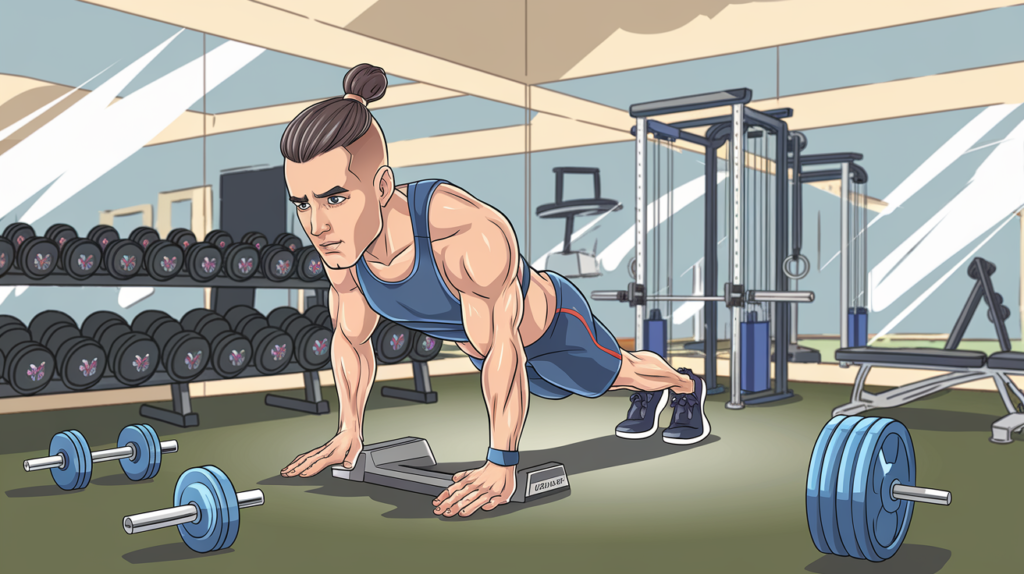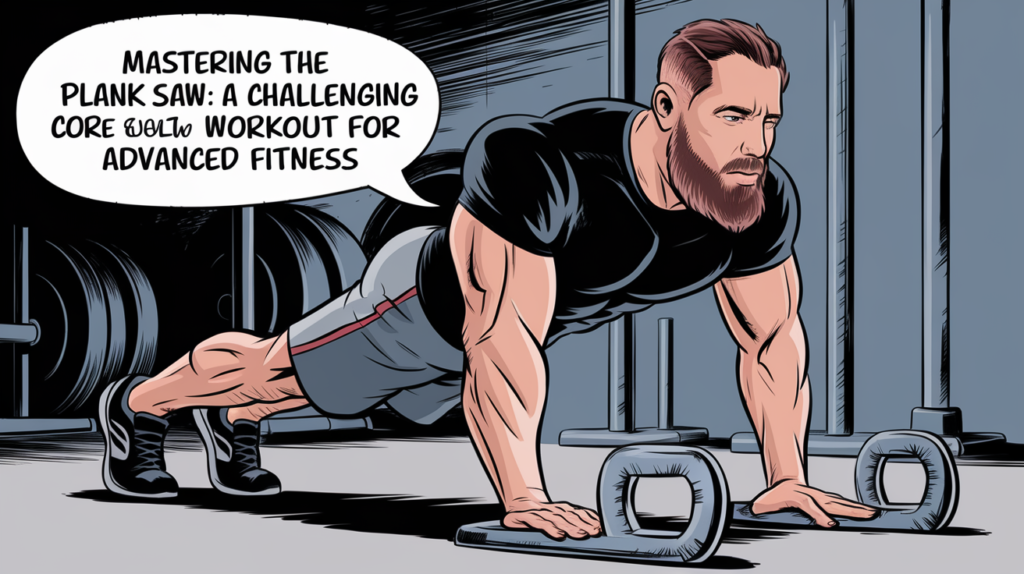The plank saw is an advanced core exercise that takes the traditional plank to the next level. By incorporating a back-and-forth motion, the plank saw intensifies the challenge to your core, shoulders, and upper body, making it an ideal move for those looking to elevate their fitness routine. In this guide, we’ll explore the benefits of the plank saw, how to perform it correctly, common mistakes to avoid, and tips for integrating it into your workout for maximum results.
Why the Plank Saw is Effective

The plank saw is a dynamic variation of the plank that offers several unique benefits:
Read more How to Use Plank Exercise to Reduce Belly Fat: Tips and Techniques
1. Enhanced Core Engagement
Unlike the traditional plank, which is static, the plank saw adds movement that challenges the core muscles even more. The sliding motion forces your core to work harder to maintain stability, engaging the rectus abdominis, transverse abdominis, and obliques to a greater extent.
2. Improved Shoulder Stability
The forward and backward motion in the plank saw places additional demands on the shoulders, particularly the deltoids and rotator cuff muscles. This helps improve shoulder stability and strength, which is crucial for upper body exercises and overall functional fitness.
3. Increased Difficulty
The plank saw is more challenging than a standard plank, making it an excellent choice for advanced fitness enthusiasts who want to push their limits. The added movement increases the intensity, requiring greater strength, endurance, and control.
if you love travel
4. Full-Body Engagement
While the core and shoulders are the primary focus, the plank saw also engages the glutes, quadriceps, and lower back. This full-body engagement ensures that you’re building strength and stability throughout your entire body.
5. Functional Fitness
The plank saw mimics real-life movements that require coordination and control, such as pushing and pulling. Incorporating this exercise into your routine can enhance your functional fitness, improving your performance in sports and daily activities.
How to Perform the Plank Saw Correctly

To get the most out of the plank saw and avoid injury, it’s essential to perform the exercise with proper form. Here’s a step-by-step guide:
1. Start in a Forearm Plank Position
- Begin by positioning yourself in a forearm plank with your elbows directly under your shoulders, your forearms parallel to each other, and your body forming a straight line from head to heels. Your feet should be close together, and your core should be fully engaged.
2. Engage Your Core
- Tighten your core muscles by pulling your belly button towards your spine. This engagement helps stabilize your body and prevents your hips from sagging during the movement.
3. Initiate the Sawing Motion
- Begin the sawing motion by shifting your body weight forward, moving your shoulders slightly past your elbows. Then, push your body backward, moving your shoulders behind your elbows. Your forearms should remain stationary on the floor while your body glides back and forth.
4. Maintain Proper Alignment
- Throughout the movement, keep your body in a straight line, avoiding any sagging or arching in the lower back. Your hips should stay level, and your neck should remain neutral, with your gaze focused slightly ahead.
5. Control the Movement
- The key to an effective plank saw is control. Move slowly and deliberately, focusing on maintaining tension in your core and shoulders throughout the entire range of motion.
6. Breathe Steadily
- Inhale as you shift your body forward and exhale as you move backward. Controlled breathing helps maintain stability and focus during the exercise.
7. Perform Repetitions
- Aim for 8-12 controlled repetitions, focusing on quality over quantity. As you build strength and endurance, you can increase the number of repetitions or extend the duration of the exercise.
Common Mistakes to Avoid

To maximize the effectiveness of the plank saw and prevent injury, avoid these common mistakes:
1. Sagging Hips
Allowing your hips to sag towards the floor reduces core engagement and can strain your lower back. Keep your core tight and your body in a straight line throughout the movement.
2. Arching the Lower Back
An arched lower back can lead to discomfort and potential injury. Focus on maintaining a flat back by engaging your core and glutes.
3. Rushing the Movement
Performing the plank saw too quickly can compromise form and reduce the effectiveness of the exercise. Slow, controlled movements are key to maximizing muscle engagement.
4. Inadequate Core Engagement
Failing to fully engage the core can lead to poor form and reduced effectiveness. Focus on pulling your belly button towards your spine and keeping your core tight throughout the exercise.
Variations and Progressions for the Plank Saw

Once you’ve mastered the basic plank saw, you can try these variations and progressions to increase the challenge and further develop your strength:
1. Plank Saw with Sliders
Using sliders under your feet adds an additional layer of difficulty by increasing the range of motion and requiring more control.
- How to Perform:
- Place sliders under your toes and perform the plank saw as described, focusing on controlled, smooth movements.
2. Weighted Plank Saw
Adding a weight plate on your back increases the intensity, requiring greater strength and stability.
- How to Perform:
- Place a light weight plate on your back (make sure it’s secure) and perform the plank saw as described. Start with a lighter weight and gradually increase as you build strength.
3. Single-Leg Plank Saw
Lifting one leg during the plank saw further challenges your balance and core stability, making the exercise more difficult.
- How to Perform:
- Perform the plank saw with one leg lifted off the ground, keeping it straight and in line with your body. Alternate legs with each set.
4. Plank Saw with Reach
Adding an arm reach increases the challenge for your shoulders and core by introducing an element of instability.
- How to Perform:
- As you move your body forward, extend one arm straight out in front of you. Return to the starting position and repeat with the other arm.
Tips for Maximizing Your Plank Saw Workout
To get the most out of the plank saw, follow these tips:
1. Focus on Form
Proper form is crucial for maximizing the effectiveness of the plank saw and preventing injury. Take your time to perfect your technique before increasing intensity or adding variations.
2. Start with Short Sets
If you’re new to the plank saw, start with shorter sets (e.g., 5-6 reps) and gradually increase as you build strength and endurance.
3. Incorporate into a Full-Body Workout
The plank saw can be a great addition to a full-body workout routine. Pair it with other compound exercises like squats, lunges, and push-ups for a comprehensive strength workout.
4. Challenge Yourself with Variations
As you become more comfortable with the plank saw, challenge yourself by trying more advanced variations or increasing the intensity with added resistance.
5. Stay Consistent
Consistency is key to seeing results. Incorporate the plank saw into your routine 2-3 times per week to build core strength and stability.
Incorporating the Plank Saw into Your Workout Routine
Here are some ways to integrate the plank saw into your existing fitness routine:
1. Core-Focused Workouts
Include the plank saw in a core-focused workout along with other exercises like leg raises, Russian twists, and mountain climbers. This will help you develop a strong, stable core.
2. Upper Body Circuits
Pair the plank saw with upper body exercises like push-ups, shoulder presses, and rows for a challenging circuit that targets the core and upper body.
3. Full-Body Workouts
Incorporate the plank saw into a full-body workout that includes lower body exercises like squats and deadlifts. This ensures you’re engaging multiple muscle groups and building overall strength.
4. Warm-Up or Cool-Down
Use the plank saw as part of your warm-up to activate your core and shoulders, or as a cool-down to focus on core stability after a workout.
Conclusion
The plank saw is a challenging and effective exercise for advanced fitness enthusiasts looking to build core strength, improve shoulder stability, and enhance overall functional fitness. By mastering the basic form and gradually progressing to more challenging variations, you can make the plank saw a powerful addition to your workout routine. Focus on proper form, incorporate the exercise consistently, and challenge yourself with new variations to achieve your fitness goals. With dedication and practice, the plank saw can help you build a stronger, more stable core and elevate your overall fitness level.







[…] Mastering the Plank Saw: A Challenging Core Workout for Advanced Fitness […]